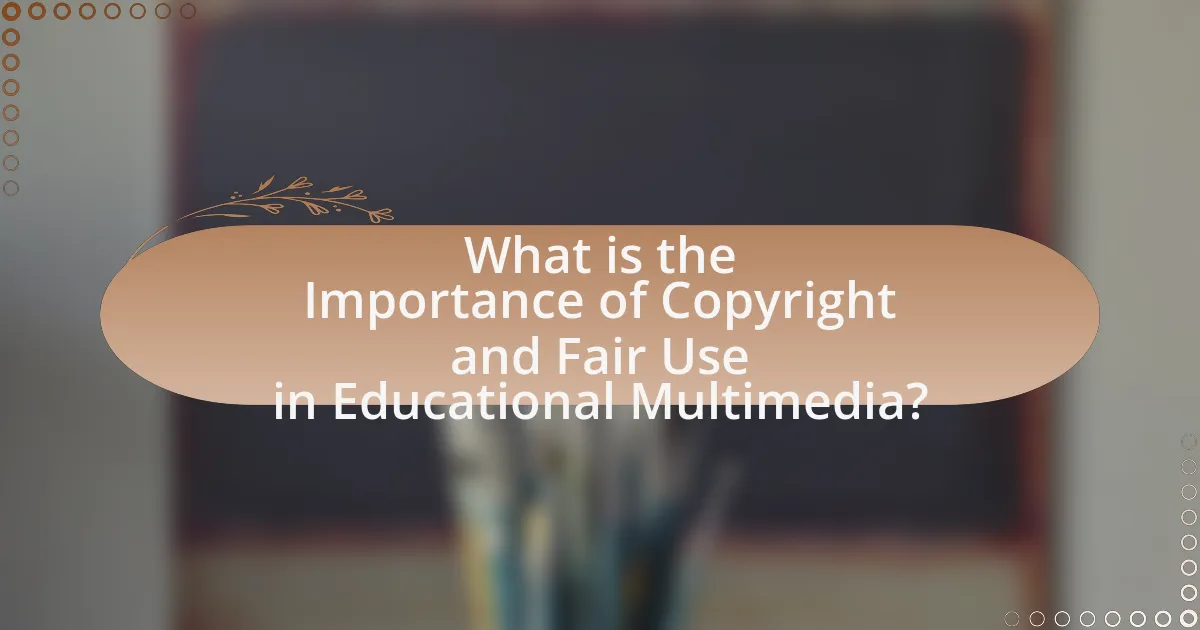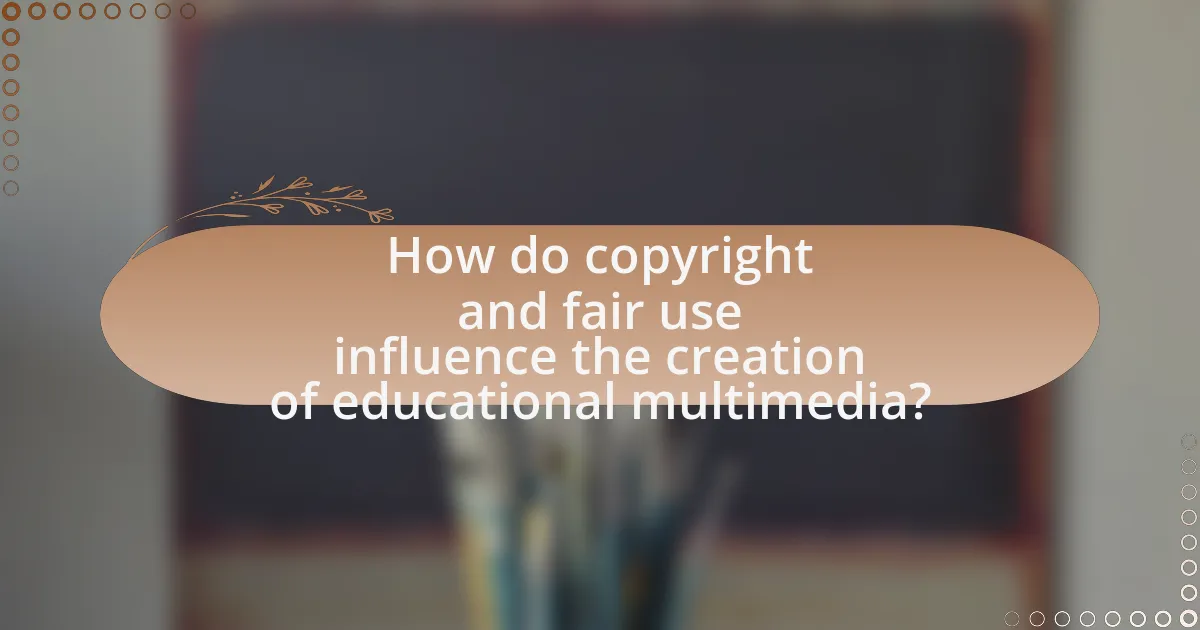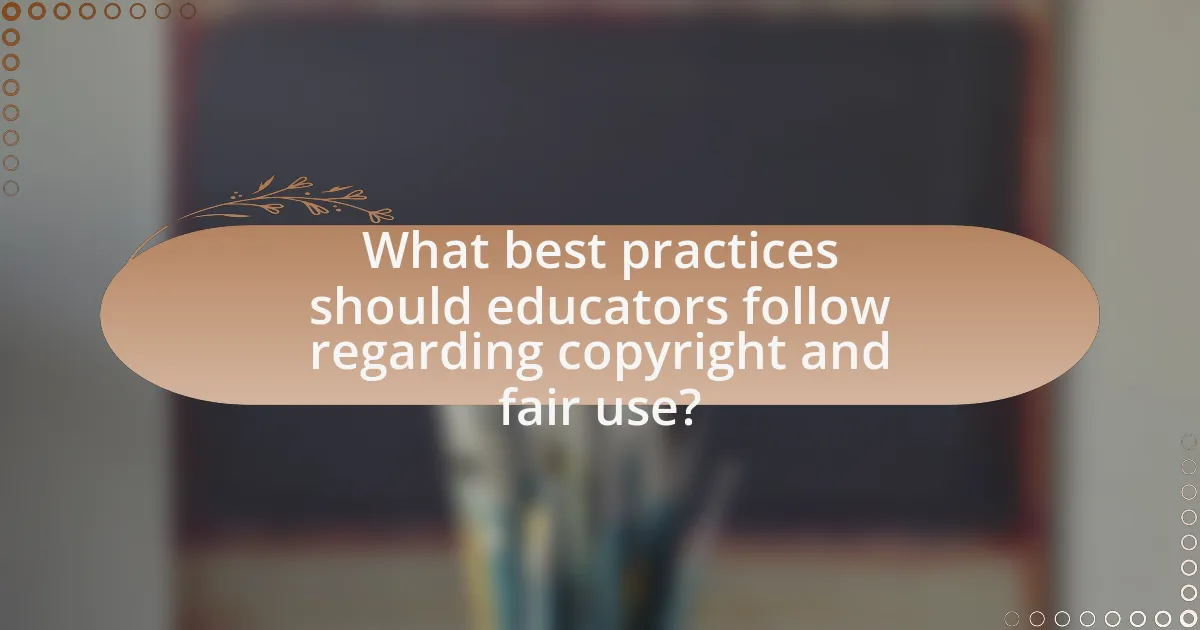The article focuses on the significance of copyright and fair use in educational multimedia, emphasizing their role in protecting creators’ rights while enabling educators to utilize various materials for teaching. It outlines the essential principles of copyright law, including the exclusive rights granted to creators and the limitations imposed by fair use, which allows for limited use of copyrighted material in educational contexts. The article also discusses the implications of copyright violations for educators and institutions, the factors determining fair use, and best practices for navigating copyright issues in educational settings. Additionally, it highlights resources available for educators to ensure compliance with copyright laws and promote ethical use of multimedia among students.

What is the Importance of Copyright and Fair Use in Educational Multimedia?
Copyright and Fair Use are crucial in educational multimedia as they protect creators’ rights while allowing educators to utilize materials for teaching purposes. Copyright ensures that authors and creators receive recognition and compensation for their work, fostering innovation and creativity. Fair Use, defined under U.S. copyright law, permits limited use of copyrighted material without permission for educational purposes, such as criticism, comment, news reporting, teaching, scholarship, or research. This balance enables educators to enhance learning experiences while respecting intellectual property rights. For instance, the U.S. Supreme Court case Campbell v. Acuff-Rose Music, Inc. established that transformative use can qualify as Fair Use, reinforcing the importance of these legal frameworks in promoting educational access and creativity.
Why is copyright essential in educational settings?
Copyright is essential in educational settings because it protects the intellectual property rights of creators, ensuring that educators and students can access and use materials legally. This legal framework encourages the creation of new educational resources by providing creators with the assurance that their work will not be exploited without permission. For instance, the U.S. Copyright Act of 1976 grants authors exclusive rights to their works, which fosters innovation and creativity in educational content. Additionally, copyright laws help maintain academic integrity by preventing plagiarism and promoting respect for original ideas, thereby enhancing the overall quality of education.
What are the fundamental principles of copyright law?
The fundamental principles of copyright law include the protection of original works of authorship, the exclusive rights granted to creators, and the limitation of those rights through fair use. Copyright law safeguards the expression of ideas in various forms, such as literature, music, and art, ensuring that creators have the exclusive right to reproduce, distribute, and display their works. This legal framework is designed to encourage creativity and innovation by providing economic incentives to authors and artists. Fair use serves as a critical limitation, allowing limited use of copyrighted material without permission for purposes such as education, criticism, and commentary, thereby balancing the interests of creators with the public’s right to access information.
How does copyright protect creators in educational multimedia?
Copyright protects creators in educational multimedia by granting them exclusive rights to their original works, which includes the ability to reproduce, distribute, and display their content. This legal framework ensures that creators can control how their multimedia is used, preventing unauthorized use or exploitation by others. For instance, under the U.S. Copyright Act, creators automatically receive copyright protection upon the creation of their work, which allows them to seek legal recourse against infringement. This protection encourages innovation and investment in educational resources, as creators can monetize their work and receive recognition for their contributions.
What is fair use and how does it apply to educational multimedia?
Fair use is a legal doctrine that allows limited use of copyrighted material without permission from the rights holder, particularly for purposes such as criticism, comment, news reporting, teaching, scholarship, or research. In the context of educational multimedia, fair use enables educators to incorporate copyrighted materials—like images, videos, and text—into their teaching resources without seeking permission, provided the use meets certain criteria. These criteria include the purpose and character of the use (educational and non-commercial), the nature of the copyrighted work (factual works are more likely to be fair use), the amount and substantiality of the portion used (using smaller, less significant portions is favored), and the effect of the use on the market for the original work (if it does not harm the market value, it is more likely to be considered fair use).
What are the four factors that determine fair use?
The four factors that determine fair use are: the purpose and character of the use, the nature of the copyrighted work, the amount and substantiality of the portion used, and the effect of the use on the market for the original work. Each factor plays a critical role in assessing whether a specific use qualifies as fair use under copyright law. For instance, transformative uses that add new meaning or message are more likely to be considered fair use, while commercial uses may weigh against it. The nature of the work, whether factual or creative, also influences the fair use analysis, as factual works are more likely to be subject to fair use. Additionally, using smaller portions of a work typically favors fair use, while using a significant portion may not. Lastly, if the new use negatively impacts the market for the original work, it is less likely to be deemed fair use.
How can educators assess whether their use qualifies as fair use?
Educators can assess whether their use qualifies as fair use by applying the four-factor test established by U.S. copyright law. This test evaluates the purpose and character of the use, the nature of the copyrighted work, the amount and substantiality of the portion used, and the effect of the use on the market for the original work. For instance, if educators use a small excerpt of a copyrighted text for educational purposes, this may favor fair use, especially if the use is transformative and does not harm the market value of the original work. The U.S. Copyright Office provides guidelines that further clarify these factors, emphasizing that no single factor is determinative, and all must be considered in context.
What are the consequences of ignoring copyright and fair use?
Ignoring copyright and fair use can lead to legal repercussions, including lawsuits and financial penalties. When individuals or organizations use copyrighted material without permission, they risk infringing on the rights of the copyright holder, which can result in costly legal battles. For instance, a study by the Copyright Alliance indicates that copyright infringement can lead to damages ranging from $750 to $30,000 per work, depending on the nature of the infringement. Additionally, educational institutions may face loss of credibility and funding if found in violation of copyright laws, as they are expected to uphold ethical standards in their use of multimedia resources.
What legal repercussions can educators face for copyright infringement?
Educators can face legal repercussions for copyright infringement, including monetary damages, injunctions, and potential disciplinary actions from their institutions. When educators use copyrighted materials without permission or fail to comply with fair use guidelines, they risk being sued by copyright holders, which can result in statutory damages ranging from $750 to $30,000 per work infringed, or even up to $150,000 for willful infringement. Additionally, educators may face institutional consequences, such as loss of employment or professional licensure, depending on the severity of the infringement and the policies of their educational institutions.
How can copyright violations impact educational institutions?
Copyright violations can significantly impact educational institutions by exposing them to legal liabilities and financial penalties. When institutions use copyrighted materials without permission, they risk lawsuits from copyright holders, which can lead to costly settlements or damages. For instance, a study by the Association of American Universities found that institutions faced an average of $100,000 in legal fees per copyright infringement case. Additionally, such violations can damage the institution’s reputation, leading to a loss of trust among students, faculty, and the community. This can hinder the institution’s ability to attract new students and secure funding, ultimately affecting its educational mission.

How do copyright and fair use influence the creation of educational multimedia?
Copyright and fair use significantly influence the creation of educational multimedia by establishing legal boundaries for content usage and encouraging innovation. Copyright protects original works, ensuring creators retain control over their materials, which can limit the availability of resources for educators. However, fair use allows for limited use of copyrighted material without permission for educational purposes, fostering creativity and enabling the incorporation of diverse content in multimedia projects. For instance, the U.S. Copyright Act of 1976 outlines specific criteria for fair use, such as the purpose of use, the nature of the copyrighted work, the amount used, and the effect on the market value, which educators must navigate to create compliant and effective educational multimedia.
What types of multimedia are affected by copyright laws?
Copyright laws affect various types of multimedia, including music, videos, images, and software. These forms of multimedia are protected under copyright to ensure that creators retain rights over their original works. For instance, music compositions and recordings are protected to prevent unauthorized reproduction and distribution, while videos and films are safeguarded against unauthorized use. Images, including photographs and illustrations, also fall under copyright protection, which prohibits their use without permission from the creator. Additionally, software code is protected to prevent unauthorized copying and distribution, ensuring that developers maintain control over their intellectual property.
How does copyright apply to images, videos, and music in educational content?
Copyright protects images, videos, and music used in educational content, granting creators exclusive rights to their works. This means that educators must obtain permission or licenses to use copyrighted materials unless the use qualifies as fair use, which allows limited use without permission for purposes like teaching, scholarship, or research. Fair use is determined by factors such as the purpose of use, the nature of the copyrighted work, the amount used, and the effect on the market value of the original work. For instance, using a short clip of a video for analysis in a classroom setting may be considered fair use, while using an entire film would likely not be.
What are the implications of using copyrighted materials in presentations?
Using copyrighted materials in presentations can lead to legal repercussions, including copyright infringement claims. When individuals incorporate copyrighted content without permission, they risk facing lawsuits, financial penalties, and the removal of their presentations. According to the U.S. Copyright Office, unauthorized use of copyrighted works can violate the rights of the copyright holder, which may result in legal action. Additionally, educational institutions may impose disciplinary measures against individuals who fail to adhere to copyright laws, further emphasizing the importance of understanding fair use guidelines.
How can educators navigate copyright when creating their own multimedia?
Educators can navigate copyright when creating their own multimedia by understanding and applying the principles of fair use, which allows limited use of copyrighted material without permission under specific circumstances. Fair use is determined by four factors: the purpose of use (educational purposes are favored), the nature of the copyrighted work (factual works are more likely to be considered fair use), the amount used (using smaller portions is more favorable), and the effect on the market value of the original work (if it does not harm the market, it is more likely to be fair use). Additionally, educators should consider using Creative Commons licensed materials, which provide clear permissions for use, or public domain resources, which are free from copyright restrictions. Understanding these guidelines helps educators create multimedia that respects copyright laws while enhancing educational experiences.
What resources are available for educators to ensure compliance with copyright laws?
Educators can access several resources to ensure compliance with copyright laws, including the U.S. Copyright Office, which provides comprehensive guidelines on copyright regulations and fair use. Additionally, the Association of Educational Publishers offers resources specifically tailored for educators, including best practices for using copyrighted materials in educational settings. The Creative Commons organization also provides licenses that allow educators to legally share and use creative works, promoting compliance with copyright laws. Furthermore, many universities offer copyright training and workshops to help educators understand their rights and responsibilities regarding copyrighted materials. These resources collectively support educators in navigating copyright issues effectively.
How can educators obtain permissions for copyrighted materials?
Educators can obtain permissions for copyrighted materials by directly contacting the copyright holder or their representative to request authorization for use. This process typically involves identifying the specific materials needed, explaining the intended use, and providing any necessary details about the educational context. According to the U.S. Copyright Office, many copyright holders are willing to grant permissions, especially for educational purposes, as long as the request is clear and respectful.

What best practices should educators follow regarding copyright and fair use?
Educators should adhere to best practices regarding copyright and fair use by understanding the limitations and allowances of using copyrighted materials in educational settings. Specifically, they should familiarize themselves with the fair use doctrine, which permits limited use of copyrighted works without permission for purposes such as criticism, comment, news reporting, teaching, scholarship, or research.
Additionally, educators should seek to use materials that are in the public domain or licensed under Creative Commons, as these resources are explicitly made available for educational use. They should also provide proper attribution to the original creators of any materials used, ensuring that they respect the rights of copyright holders.
Furthermore, educators should limit the amount of copyrighted material used in their teaching to what is necessary for educational purposes, and they should avoid using entire works unless it falls under fair use guidelines. By following these practices, educators can effectively navigate copyright issues while fostering a respectful and legally compliant learning environment.
How can educators effectively educate students about copyright and fair use?
Educators can effectively educate students about copyright and fair use by integrating practical examples and interactive activities into their curriculum. By using real-world scenarios, such as analyzing popular media or discussing case studies, educators can illustrate the complexities of copyright law and the principles of fair use. Research indicates that experiential learning enhances understanding; for instance, a study by the American Association of Colleges and Universities found that active learning strategies significantly improve student engagement and retention of information. Additionally, providing resources such as guides, workshops, and online modules can further reinforce students’ comprehension of copyright issues.
What strategies can be implemented in the classroom to promote copyright awareness?
To promote copyright awareness in the classroom, educators can implement strategies such as integrating copyright education into the curriculum, utilizing real-world examples of copyright infringement, and encouraging discussions about fair use. Integrating copyright education ensures that students understand the legal implications of using multimedia resources, while real-world examples highlight the consequences of copyright violations, making the topic more relatable. Encouraging discussions about fair use allows students to critically analyze when and how they can use copyrighted materials legally, fostering a deeper understanding of the subject. These strategies collectively enhance students’ knowledge and respect for copyright laws, which is essential in today’s digital age.
How can educators encourage ethical use of multimedia among students?
Educators can encourage ethical use of multimedia among students by integrating lessons on copyright and fair use into the curriculum. By providing clear guidelines on what constitutes fair use, such as the purpose, nature, amount, and effect of the use on the market, educators can help students understand the legal and ethical implications of multimedia usage. Research indicates that when students are educated about copyright laws and the importance of respecting intellectual property, they are more likely to engage in responsible practices. For instance, a study by the American Association of University Professors found that 85% of students who received instruction on copyright were more aware of ethical multimedia use.
What tools and resources can assist educators in adhering to copyright laws?
Educators can utilize various tools and resources to adhere to copyright laws, including copyright management software, educational websites, and legal databases. Copyright management software, such as EasyCopyright and Copyright Clearance Center, helps educators track and manage copyrighted materials effectively. Educational websites like Creative Commons provide access to a vast repository of openly licensed resources, allowing educators to use materials legally. Additionally, legal databases such as the U.S. Copyright Office website offer comprehensive information on copyright laws and fair use guidelines, ensuring that educators remain informed about their rights and responsibilities. These resources collectively support educators in navigating copyright complexities while promoting compliance.
What online platforms provide copyright-free or licensed materials for educational use?
Online platforms that provide copyright-free or licensed materials for educational use include Wikimedia Commons, Creative Commons, and Project Gutenberg. Wikimedia Commons offers a vast collection of media files that are either in the public domain or available under Creative Commons licenses, making them suitable for educational purposes. Creative Commons itself provides a range of licenses that allow creators to share their work legally, facilitating access to educational resources. Project Gutenberg offers over 60,000 free eBooks, primarily consisting of public domain texts, which can be utilized in educational settings. These platforms collectively support the educational community by ensuring access to legally shareable materials.
How can educators stay updated on changes in copyright law and fair use guidelines?
Educators can stay updated on changes in copyright law and fair use guidelines by regularly consulting authoritative resources such as the U.S. Copyright Office website and educational organizations like the Association of Educational Publishers. These platforms provide current information on legal updates, policy changes, and best practices. Additionally, participating in professional development workshops and webinars focused on copyright issues can enhance educators’ understanding and application of these laws in their teaching practices. Regularly reviewing publications from legal experts and subscribing to newsletters from copyright advocacy groups also ensures that educators remain informed about relevant developments in copyright law.